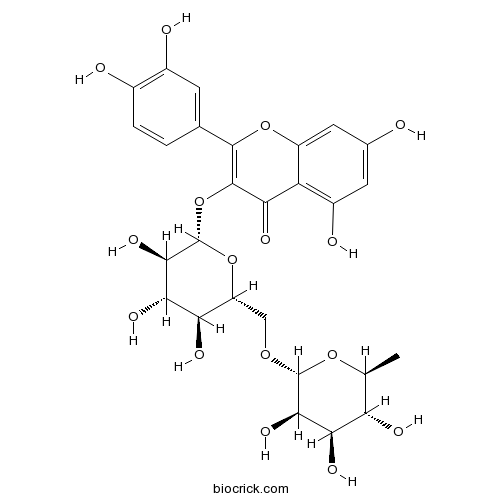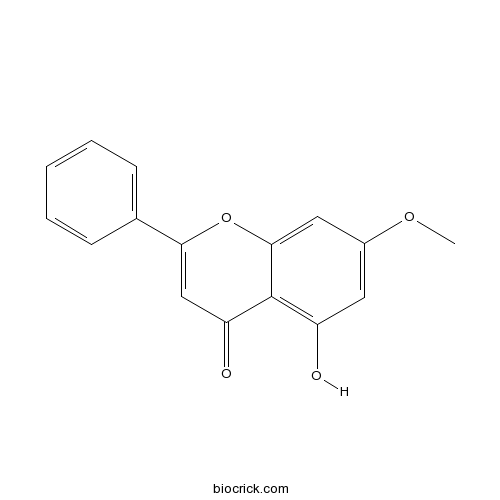Alpinia officinarum
Alpinia officinarum
1. The products in our compound library are selected from thousands of unique natural products; 2. It has the characteristics of diverse structure, diverse sources and wide coverage of activities; 3. Provide information on the activity of products from major journals, patents and research reports around the world, providing theoretical direction and research basis for further research and screening; 4. Free combination according to the type, source, target and disease of natural product; 5. The compound powder is placed in a covered tube and then discharged into a 10 x 10 cryostat; 6. Transport in ice pack or dry ice pack. Please store it at -20 °C as soon as possible after receiving the product, and use it as soon as possible after opening.
Natural products/compounds from Alpinia officinarum
- Cat.No. Product Name CAS Number COA
-
BCN1684
Rutin153-18-4
Instructions

-
BCN5556
Pinocembrin480-39-7
Instructions

-
BCN5557
Chrysin480-40-0
Instructions

-
BCN5655
Tectochrysin520-28-5
Instructions

-
BCN5658
Apigenin520-36-5
Instructions

-
BCN5730
Galangin548-83-4
Instructions

[Materiamedica literature study on medicinal properties and utility of four kinds of Alpinia Chinese medicines].[Pubmed: 30111012]
In order to explore the correlation between the medicinal properties,efficacy and application in the same genetic relationship,explain the scientific connotation of the medicinal properties and effects of traditional Chinese medicines(TCM),promote the academic development of the theory of traditional Chinese medicines,and provide reference for the research and development of the traditional Chinese medicines of a same genus. In this paper, a literature study of ancient and modern works of Chinese herbal medicine was conducted to investigate the correlation between the properties, meridians tropism, efficacy and application of Alpinia officinarum, A. katsumadai, Galangae Fructus and Alpinae Oxyphyllae Fructus, four kinds of Alpinia Chinese medicines.The results showed that the similar properties of these four kinds of Alpinia Chinese medicines included that they were acrid, warm,and mainly getting into the spleen and stomach channels; the similar efficacies included that dispelling cold,relieving pain,warming stomach,anti-nausea,anti-diarrheal,reinforcing spleen to promote digestion and other effects; in application aspects, the similarities were that they were all mainly used in treatment of catching cold or spleen deficiency induced by abdominal pain,vomiting,diarrhea,diet indigestion, etc. indicating that phylogenetic relationship was closely related with the herbal properties, efficacy and application. It is an effective way to explore,collate and research traditional Chinese medicine by using plant phylogenetic relationships in exploring the internal relations and laws of TCM theories,material bases, pharmacological effects and clinical applications, also with a strong maneuverability to explain their scientific connotation.
Galangin, a dietary flavonoid, ameliorates hyperglycaemia and lipid abnormalities in rats with streptozotocin-induced hyperglycaemia.[Pubmed: 29952676]
Galangin, a natural flavonoid, is found in honey and Alpinia officinarum Hance (Zingiberaceae). Galangin has antiviral, antimicrobial, antidiabetic and anticancer properties, without side effects. The effects of galangin on hyperglycaemia and lipid abnormalities are not known.
A review on the ethnomedicinal uses, phytochemistry and pharmacology of Alpinia officinarum Hance.[Pubmed: 29803568]
Alpinia officinarum Hance is a perennial plant that has been traditionally used for many decades to treat several ailments including inflammation, pain, stomach-ache, cold, amongst others. Pharmacological studies over the years have demonstrated remarkable bioactivities that could be further explored for development of new therapeutic agents against various ailments.
Evaluation of the chemopreventive effects of Ankaferd Bloodstopper in 7,12-dimethylbenz[a]anthracene-induced oral epithelial dysplasia.[Pubmed: 29500540]
Ankaferd BloodStopper® (ABS) is an herbal extract which has been used historically as a hemostatic agent in traditional Turkish medicine. ABS comprises of standardized mixture of herbs Thymus vulgaris, Glycyrrhiza glabra, Vitis vinifera, Alpinia officinarum, and Urtica dioica. In addition to its hemostatic effects, the herb ABS contains some other biological effects including antioxidant and antitumoral properties. The aim of this study is to investigate the chemopreventive effects of ABS in 7,12-dimethylbenz[a]anthracene (DMBA)-induced oral epithelial dysplasia.
Isolates from Alpinia officinarum Hance attenuate LPS-induced inflammation in HepG2: Evidence from in silico and in vitro studies.[Pubmed: 29468851]
In an attempt to connect the legacy of centuries of invaluable knowledge from traditional medicine and the current understanding to the molecular mechanism of diseases, we took the advantage of the emergence of in silico screening as a promising tool for identification of potential leads from libraries of natural products. Traditional Chinese Medicine database was subjected to structure based virtual screening for identification of anti-inflammatory compounds using the 3D crystal structure of p38 alpha mitogen activated protein kinase. The molecular docking studies revealed the potential activity of several classes of compounds known to be the constituents of the rhizomes of Alpinia officinarum Hance (Lesser galangal). Five compounds, galangin, kaempferide, isorhamnetin, and two diarylheptanoids, were isolated from the rhizomes of the plant using vacuum liquid chromatography and flash chromatography techniques. The anti-inflammatory activity of these compounds was investigated on HepG2 cells stimulated by lipopolysaccharide. The latter induced the gene expression of proinflammatory cytokines; interleukin-1β, interleukin-6, tumor necrosis factor alpha. Addition of the 5 isolated compounds downregulated this increased gene expression in a dose dependent manner. Thus, these results indicate that the isolated compounds from A. officinarum could be used as a beneficial source for preventing and treating inflammatory diseases.


